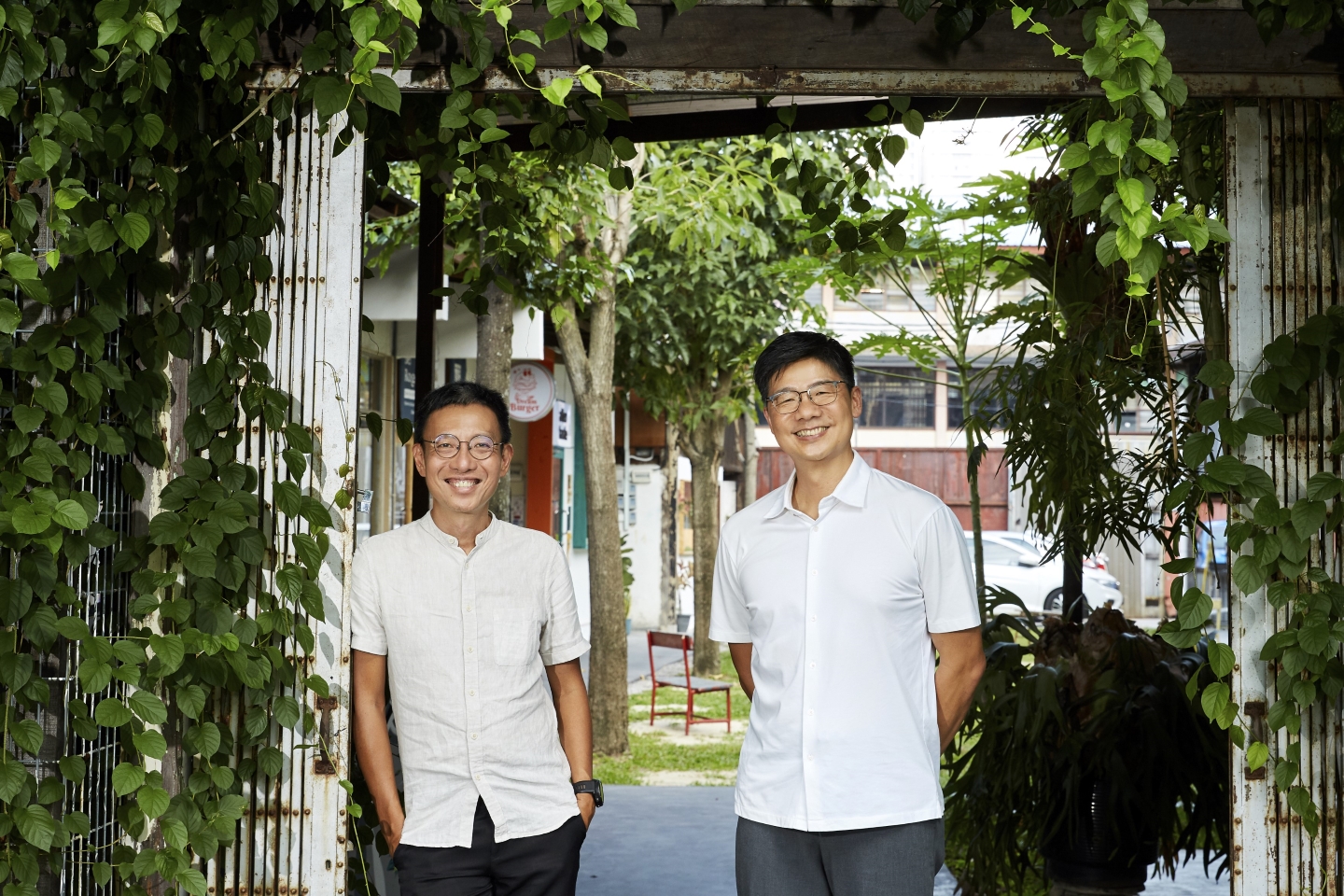
Mei (left) and Tan of Coex and Hin Bus Depot (All photos: SooPhye)
It was Edward de Bono, creator of the term “lateral thinking”, who commented, “There is no doubt that creativity is the most important human resource of all. Without creativity, there would be no progress, and we would be forever repeating the same patterns”.
Having been the frontrunner for creativity in Penang for some time now, Hin Bus Depot — which turns 10 next year — recently reignited that spark all over again by adding a new component: an expansive, creative space named Coex, leased and led by the head of a thriving architectural practice.
The origins of creativity
Situated on what used to be an old scrap metal yard, Coex is, in essence, Hin Bus Depot in miniature. Infused with the same spirit of adventurous creativity, Coex’s business ethos strongly encourages freedom of self-expression while providing the supportive framework of a community that makes it easy to do so.
But lest the unfamiliar ask what Hin Bus Depot is in the first place, it is best described as the result of sweet serendipity, a series of fortunate events that occurred when Lithuanian street artist Ernest Zacharevic (who incidentally put George Town on the world map with his charming street art murals) chanced upon the overgrown site of what had been the Hin Company Bus Depot while searching for a venue to host his first solo exhibition.
Established by the colonial government after WWII as part of its efforts to restore Penang, Hin Company Ltd was, at one time, the island’s most stylish private motorbus company whose blue coaches regularly plied the northwest route from Prangin to Tanjung Bungah and along the western seaboard to a terminus in Teluk Bahang. After the company closed in 1999, its garage and depot in what was then Brick Kiln Road (now Jalan Gurdwara) was likewise shuttered and abandoned.
It was only in 2013 when Zacharevic, after spotting vestiges of the site’s original Art Deco architecture, insisted it was perfect for his Art is Rubbish is Art exhibition that the three families who owned the 60,000 sq ft plot agreed to having the derelict depot cleaned and fixed up; but only just enough so that the show could be held.
The tremendous reception by an appreciative public when it opened in January 2014 was enough to change their minds.
“After pouring love into the project, we also didn’t want to let Hin go back to ruin once more,” says Tan Shih Thoe, 51, managing director of Lum Choon & Co and a member of the trio of families.
_s1a8795a.jpg
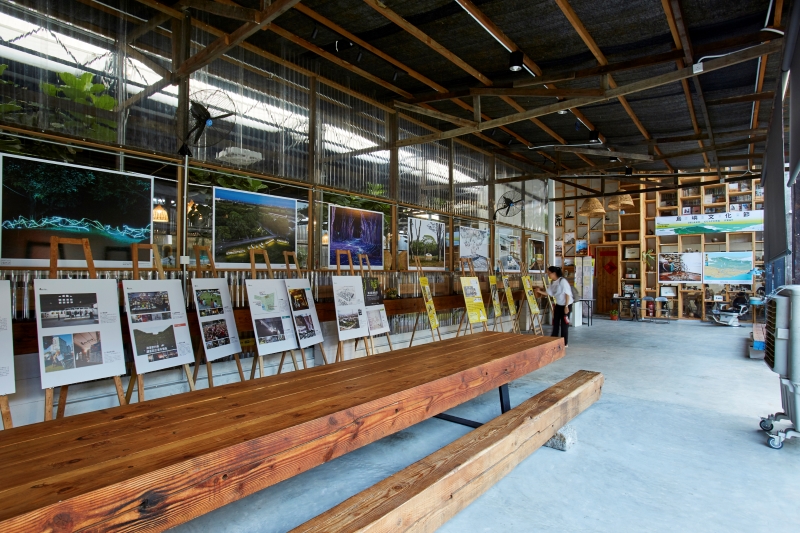
Forged from steel
With the families’ backing and blessing, and under Tan’s watch, Hin Bus Depot soon became a space where art, artists and art forms in all their various guises were welcomed and encouraged, buoyed along by an enthusiastic community of like-minded people. A quick glance today shows an eclectic list of tenants, ranging from the Michelin-starred Restaurant Au Jardin to clothing and streetwear boutique The Swagger Salon and cocktail bar Backdoor Bodega. For Tan, though, there was room still for more creative energy.
His last parcel of land, a former kilang besi buruk spanning 9,600 sq ft, meant that it was way bigger than what any of his existing pool of lessees could fill. But leaving it empty would mean inefficient use of prime land that is practically on the doorstep of George Town’s designated Unesco World Heritage Site, not to mention potential loss of rental earnings for Hin Bus Depot.
“It really is serendipity,” says Tan. “I had meant for and wanted this space to host new and different programmes for Hin. And then, not long after, I met Mei.”
Two bright sparks
The “Mei” in question is none other than architect Mei Chee Seong, 52, who co-founded ALM, a renowned, award-winning multi-disciplinary practice of over 40 architects and urban designers, in 2003 together with Liew Tze Siang (the name ALM stems from their core practice of architecture and their initials).
Introduced in 2021 by mutual friend Lee Khai, a well-known litigator but with great influence in the arts due, in part, to his position as chairman of the Penang State Art Gallery and board member of the Penang State Museum, Tan and Mei hit it off instantly. Soon after, Mei let slip he was looking for a place where “things could happen”.
“Besides being an architect, Mei is an artist himself and very into art programming,” Tan shares. “He has done so much in such a short period of time. Truly, everything he put on complements what we do at Hin so well. It really is two forces of energy aligned.”
On the serendipitous connection, Mei weighs in, saying, “I am actually an Alor Setar boy … a Kedah gu (ox, in Hokkien), as people like to tease. But yes, I had wanted something bigger than what we already do … I wanted room to imagine, to dream. ALM already had its offices settled at e-Gate when I proposed moving our 40-strong practice to Hin. It was a big step. I mean, e-Gate was in a good location, known to all Penangites and comfortable. But what I realised in my 17 to 18 years of practice is that you cannot grow further by remaining in your comfort zone. And so I wanted a more impactful lifestyle and dynamic work environment for myself and my colleagues, a place where we could challenge ourselves creatively on all fronts”.
This resulted in a massive uprooting from Gelugor to Jalan Gurdwara in September 2022 after they signed a standard 3+3 years tenancy agreement.
_s1a8772a.jpg
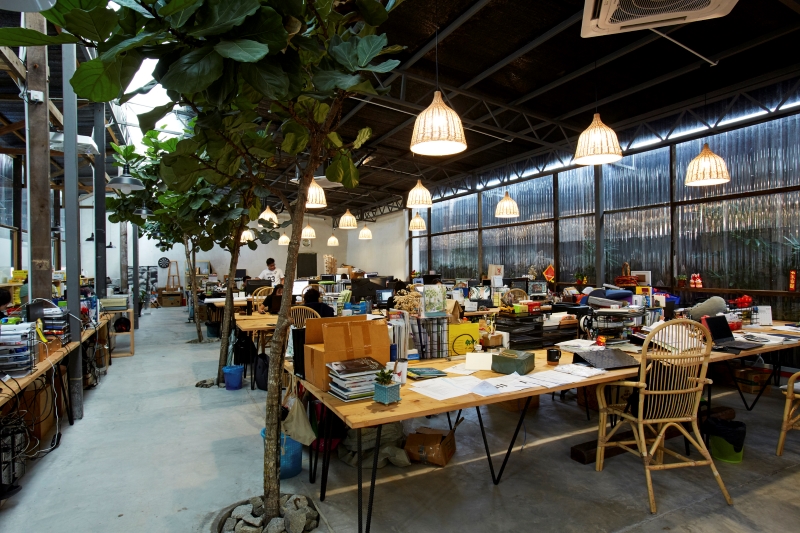
“Although the difference in distance wasn’t great, the environment was completely … It was so different and exciting,” Mei adds. “Hin Bus Depot is really a very creative space. When I first mentioned moving here to the team, I was peppered with questions. Everyone was curious. Some had heard of it but not all had been [there].
“Hin, as an already mature creative space, meant our new little ecosystem could fit in and thrive relatively easily. So, despite the challenges of working much closer to the heritage zone, which brings with it heavier traffic, poorer transport connectivity and occasional tourist disturbances, it has worked very well for us. And this is a crucial element to take note of, for if it was not handled well, ALM stood to lose productivity, not to mention talents.”
“Penangites tend to share a special bond. It’s innate,” Tan notes, who likens island life to a close-knit village, where it’s easy to connect with one another and access support. “This kampung spirit is exceptionally strong among us! Whenever we meet, we always say ‘Lai, lai. Ka lau juak.’ (Come, come, it will be merrier, in Hokkien.)
In Penang, there is the understanding that we need each other’s assistance. Hin Bus Depot is a prime example of this, as it stands as a testament to the power of collective effort. It remains a place where the arts community comes together, supporting one another in all aspects of an exhibition, from setting up to dismantling and, of course, promoting it. Moreover, these connections are particularly vital for a place like Penang where the population is not as big and the resources not as abundant as those in larger cities. Here, knowing the right people who can offer help is crucial and the word ‘help’ resonates deeply in our conversations. We often say, ‘Let me introduce you to someone. Maybe they can help.’ This spirit of collaboration and reliance on one another is even more evident within the arts community.”
Co + ex equals?
In line with ALM’s raison d’etre, which is to create noteworthy architecture that integrates artistic and scientific values at every stage, Mei softens the statement by adding how “people are at the heart of everything we do”.
“We as architects need to know what contributes to happy living, how to design a good experience for people. Architecture, at its core, is about happiness. Our purpose is to give joy via the spaces we create — and this joy could be for the artist himself, his audience or both.”
Mei’s idea of sharing creative space and resources with ALM also means every nook, cranny and availability is fully utilised, even when his architects are not working.
“Our office has an area that doubles as tiered seating, which makes it ideal for presentations and talks. Also, take the main lawn, for example,” he says, pointing to the expanse of space between ALM and the retail lots. “After 2pm, it is shaded from the sun and opens up another space for creative ventures without the need for further energy consumption. And because we share everything, pool every resource, we have the luxury of experimenting.”
Although ALM takes up the bulk of the space at Coex, Mei resisted naming it after the architectural practice.
_s1a8777a.jpg
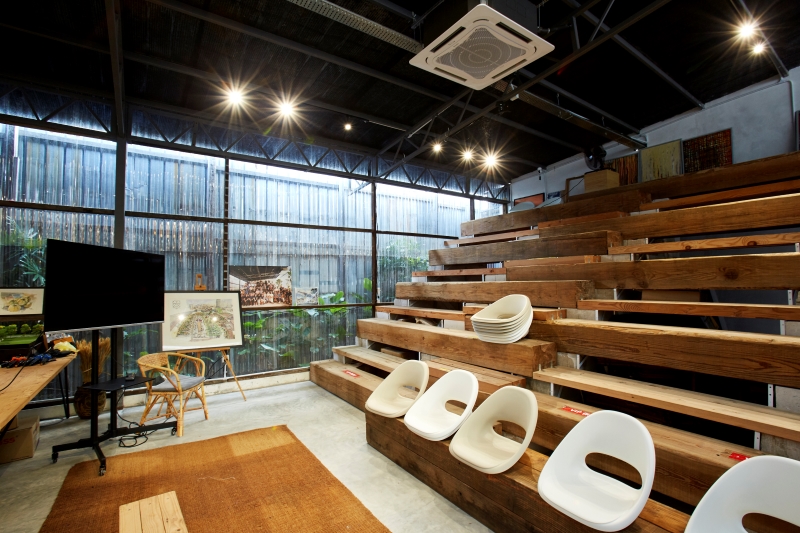
“I wanted something bigger … something that is more than what we do or stand for as architects and designers. In the end, we decided upon Coex as many words can be formed from it. From ‘co’, you get community, collaboration, contribution … even coffee,” he laughs, “while ‘ex’ can mean experiences, extra, experiment … You yourself are free to mix and match the words that underscore your idea of what Coex means to you. For us, however, it primarily stands for ‘community experiment’.”
Tan chimes in: “Mei also feels that integrating ALM within Hin is good for his team as it allows them to constantly interact with others. Within this space, you have access to several different practitioners, creatives who span genres and generations. There are musicians, chefs, artisans … The opportunity for idea sharing is endless.”
It is with this bigger picture in mind that Mei tirelessly combines daily work with his Coex dreams. Besides those exhibiting or performing whenever opportunity permits, there are several fixed sub-tenants nestled within Coex as well, including a burger joint, an incense maker, a jeweller who makes historic pieces using broken ceramics salvaged from the 1625 Wanli shipwreck and a potehi (glove puppetry) company that performs an ancient form of Chinese puppetry based on legends such as The Monkey King Adventures and historically presented in the Hokkien dialect, although other languages are being used now to reflect Malaysia’s cultural diversity. Fans of literature will enjoy browsing Dao Du (or Book Island), an indie bookstore that offers a wide range of titles in both English and Chinese, spanning culture, art and lifestyle, before perking up their senses again with a well-brewed coffee from After Taste Café next door.
On his interesting secondary line-up of tenants, Mei says there are a few key shared values each must possess.
“I only ask that the tenants be passionate people. It also has to be a venture, an enterprise, a start-up they run themselves or products they make themselves. No buying off the internet and simply reselling them here. No, no. In short, it is for a collective of makers, curators and artisans who are personally involved and have their own distinct stories to tell.”
Committed to experimenting
When ALM first decided to move in, Tan admitted to being more intrigued by Mei’s idea of what he envisioned Coex to be.
“Mei is both principal architect for ALM and mastermind of Coex, and the two ventures each presented its own set of merits. But the cherry on the cake, besides being paid rent,” jokes Tan, “is that Coex brings with it a plethora of arts and cultural programmes, making it an exciting addition. Suddenly, we found a new collaborator and content creator who happens to share the same values and vision for Hin as I do. Moreover, Coex has a certain network as well as connections in the arts and culture sector that Hin currently lacks. So, it is a perfect match. Really.”
In just over a year, Coex has hosted several interesting initiatives including the Uah Music Festival, a one-day event held two weeks after they occupied the space.
_s1a8784a.jpg
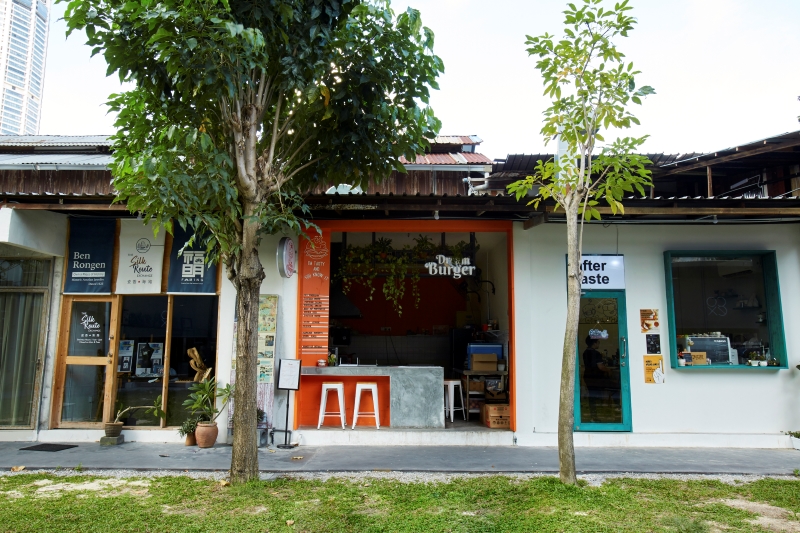
“It was on Sept 16. We didn’t curate it but were happy to provide the venue as it was a good way to introduce Coex to the public. Over 20 musical acts, from post-rock to acoustic folk, performed to a crowd of more than 200. This also gave us a chance to test the venue for public use.”
Since then, Coex has hosted a potpourri of events, from Malaysian band Soft Soft Pillow’s limited debut album launch to an Art & NFT talk, and an Art & Wellness fest featuring tea tastings, mandala art workshop, herbal chakra yoga and interactive portraiture.
“The prep time for each was very short but we are more experimental, so it works for us,” Mei notes. “We are also after short but impactful projects anyway. We are not tedious people. We do not chase for perfection but rather impact and purpose. We can curate and launch a project with just a few weeks’ lead time. Also, many of the projects are proposed by our community so we are never short of ideas. Granted, our programming has been very Sino-driven so far, but we want to be more diverse. Having said that, Coex was the recent venue for a Malay rock concert called Termangu Sendiri II. Presented by Ruas Records Store, nine bands, including Paint the Sky Red, Dirgahayu, Reset to Zilch and Ufuk Raya, played for over 10 hours.”
The law of attraction
“I’ve always believed that when you love something, you radiate brainwaves out to the world,” says Mei philosophically. “Somehow, it all comes together, drawing people of the same wavelength. It doesn’t even have to be people of the same culture or language. Recently, an Egyptian architect holidaying in Penang came across Coex and was so attracted to the space that he extended his stay for a whole month. He said it touched him … there was a spark.”
As a further example, Mei points to huge upcycled pinewood pieces that he refers to as his “treasures”, while in a corner stands vintage tin chairs rescued from a dim sum shop.
“It’s not that I find them; they find me,” he grins. “Besides, you can’t just ‘find’ these pieces as they usually aren’t listed or for sale. Almost everything here is upcycled yet meant to be. There is an overriding sense of random purposefulness. As an architect, I love that we have the ability to change what others may perceive as rubbish into something useful. My friends serve as my radar and alert me to items with potential. But I must say that any material has potential. We just need to play with it and get creative.”
“Both Hin and Coex thrive on collaborative efforts and we are continuously seeking help in content and programme creation. We need new ideas and are always open to collaborating with individuals and organisations to bring innovative and enriching experiences to Penang,” adds Tan in agreement.
_s1a8801.jpg
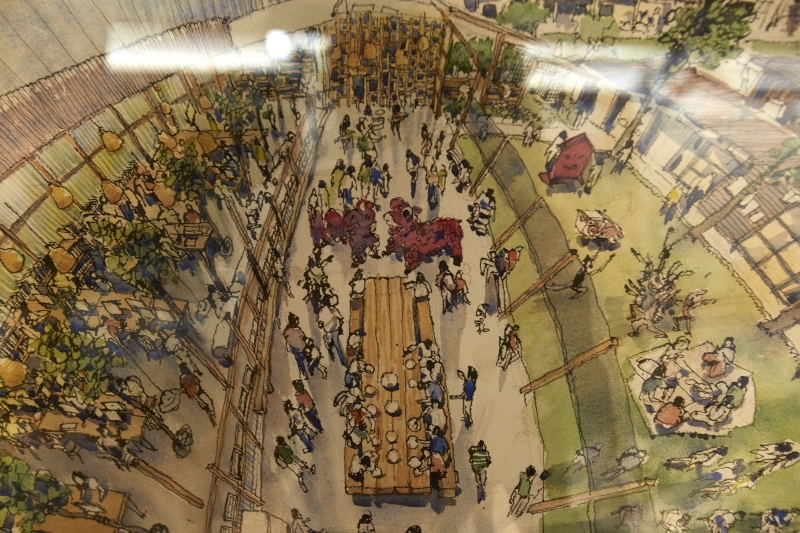
On a more serious note, he shares how Penang is facing a great shortage of affordable spaces for performing arts and studios, a gap Penangpac (which closed in January 2022) used to fill.
“Considering the property owner had been subsidising the place for over a decade, I understand their position. However, I had hoped our state government would step in and provide the necessary funds to ensure its continued existence, especially since we’ve been actively promoting Penang not just for its food, but also its vibrant arts and culture scene. Losing Penangpac is more than just losing a physical location. It’s the loss of the wealth of expertise and experience accumulated over the past 10 years. But I remain optimistic. We have dedicated individuals working at the state level and will continue to provide feedback and information if and when needed so we can work towards rectifying this situation. It’s a small bump in our journey but with collective efforts, we shall overcome.”
It takes a village
For Mei who once described Coex as “a blank canvas to be painted on by the community because everybody has their own idea of what Penang is”, it is perhaps the community itself who might prove to be the powerful push factor that will continue to drive the space forward.
“Coex is and should be a place to push boundaries,” he says thoughtfully. “And when you give people the freedom to contribute, they will come up with things that inspire others. So when people come to Coex, I want them to experience this ‘wow’ factor, to realise that they are no longer in a commercial world, limited to only what they see on the shelves, but free beings who can create and realise their dreams for themselves. Here, we want to offer things you can’t find outside. By looking inside your mind and heart, I hope everyone will see how we are not a commercial space but a place that is filled with good intentions and where all are welcome.”
Although Edward de Bono eloquently argued in favour of creativity, perhaps it is Brazil’s Romero Britto, said to be the most collected and licensed artist in history, who says it best and most succinctly: “Art is too important not to share.”
This article first appeared on Aug 28, 2023 in The Edge Malaysia.


